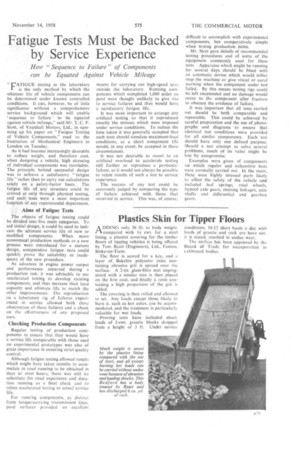Fatigue Tests Must be Backed by Service Experience
Page 73

If you've noticed an error in this article please click here to report it so we can fix it.
How "Sequence to Failure" of Components can be Equated Against Vehicle Mileage
" rATIGUE testing in the laboratory
is the only method by which the ultimate life of vehicle components can be determined under known controlled conditions. It can, however, be of little significance without a comprehensive service background which will enable sequence to failure ' to be equated against vehicle mileage," said Mr. T. C. F. Stott, of Vauxhall Motors, Ltd., in summing up his paper on "Fatigue Testing of Vehicle Components," read to the Institution of Mechanical Engineers in London on Tuesday.
As it had become increasingly desirable to reduce weight, and therefore cost, when designing a vehicle, high stressing of individual components was inevitable. The principle behind successful design was to achieve a satisfactory "fatigue life" rather than to carry out calculations solely on a safety-factor basis. The fatigue life of any structure could be arrived at only through physical testing, and such tests were a most important function of any experimental department.
Aims of Fatigue Tests The objects, of fatigue testing could be divided into five main categories. To aid initial design, it could be used to indicate the ultimate service life of new or, modified components. When more economical production methods or a new process were introduced for a current design, comparative fatigue tests could quickly prove the suitability, or inadequacy of the new procedure.
As advances in engine power output and " performance occurred during a production run, it was advisable to use accelerated testing to develop existing components, and thus increase their load capacity and ultimate life to match the other improvements. The reproduction on a laboratory rig of failures experienced in service allowed both close observation of these failures and a check on the effectiveness of any proposed cure.
Checking Production Components Regular testing of production components to ensure that they would have a service life comparable with those used on experimental prototypes was also of great importance in ensuring strict quality control.
Although fatigue testing allowed results which might have taken months to accumulate in road running to be obtained in days or even hours, there was still no substitute for road experience and duration running as a final check and to relate accelerated testing to actual service life.
For running components, as distinct from torque-carrying transmission lines, pave surfaces provided an excellent means for carrying out high-speed tests outside the laboratory. Running components Which completed 1,000 miles on pave were thought unlikely to give rise to service failures and thus would have a satisfactory fatigue life.
It was most important to arrange any artificial testing so that it reproduced exactly the stresses which were imposed under service conditions. To reduce the time taken it was generally accepted that such tests should simulate maximum-load conditions, as a short component life would, in any event, be accepted in these circumstances.
It was not desirable to resort to an artificial overload to accelerate testing still further or reproduce a particular failure, as it would not always be possible to relate results of such a test to service experience.
The success of any test could be accurately judged by comparing the type of failure achieved with those that occurred in service. This was, of course, difficult to accomplish with experimental components, but comparatively simple when testing production items.
Mr. Stott gave details of recommended testing procedures and of some of the equipment commonly used for these tests Apparatus which might be running for several days should be fitted with an automatic device which would either stop the machine or give visual or aural warning when the component under test failed. By this means testing rigs could be left unattended and no damage would occur to the component after fracture to obscure the evidence of failure.
It was important that all tests carried out should be both comparable and repeatable. This could be achieved by careful preparation and the use of photographs and diagrams to ensure that identical test conditions were provided for all similar components. Each test should have only one defined purpose. Should a test attempt to solve several problems, much of its value might be lost by compromise.
Examples were given of components on which regular and exhaustive tests were normally carried out. In the main, these were highly stressed parts likely to affect the safety of the vehicle and included leaf springs, road wheels, hypoid axle gears, steering linkages, axle shafts and differential and gearbox gears.




















































































































